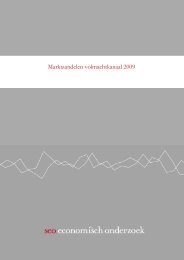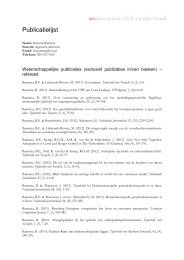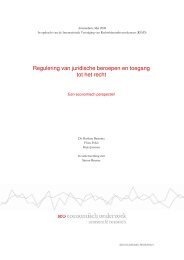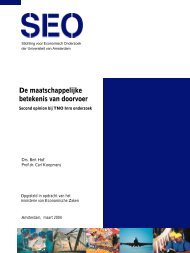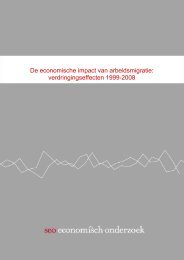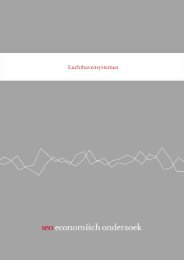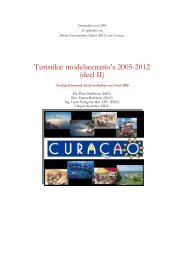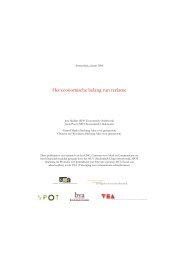challenge for the years to come will be to actually convince the private sector to increasespending on R&D.On the other hand, public R&D sponsoring in the <strong>Netherlands</strong> provides an enormous stimulus touniversity-industry collaboration (Bodas Freitas and Verspagen, 2009: 17). Dutch researchsponsors provide an organizational and interaction framework for the university-industrycollaborative projects. SenterNovem executes a number of publicly-funded programmes whichaim to promote the interaction between industry and HEIs. For example, the programmeSubsidizing Investments Knowledge Infrastructure (Besluit Subsidies InvesteringenKennisinfrastructuur) is directed towards matching the supply and demand of knowledgebetween universities and companies (SenterNovem, 2009). Another example is the InnovationVoucher (Innovatievouchers). These are virtual coupons which can be traded by entrepreneurs forknowledge available at universities and research institutions. The <strong>Netherlands</strong> Bureau forEconomic Policy Analysis (CPB) has evaluated the effect of innovation vouchers on innovationover the period 2004-05. It concludes that innovation vouchers have resulted in significantly moreimprovements in production processes (Cornet et al., 2007). No effects are found for other typesof innovation – new products, product improvements and new processes. Another finding is thatthe innovation vouchers have resulted in significantly more contract research awarded touniversities that would otherwise not have been awarded. Although there are indications thatInnovation Vouchers lead to more innovation, a cost-benefit analysis of the vouchers is has notbeen conducted (ibid).Another policy taken by the Dutch government to promote cooperative research between HEIsand industry is the institutionalization of part-time professorships with specific regulations as aform of knowledge transfer. Indeed, the exchange of industry and university positions, allowingthe expansion of their social and industrial networks and market awareness, seems to makeresearchers more productive in developing industrial innovations (Dietz and Bozeman, 2005).Furthermore, projects involving part-time professors are more likely to benefit from publicresearch sponsoring and being implemented in PhD theses (Bodas Freitas and Verspagen, 2009:18). In the <strong>Netherlands</strong>, the government has recently acted towards accommodating the growingneed for applied research in the HBO sector by introducing lectoraten. There are currently almost400 lectors working at UAS (HBO-raad, 2008b). The job specification of a lector is to transferknowledge to industry (SMEs) and society in general and to develop applications of knowledgeon demand. Initially, the required funds to appoint lectors were for 50% financed by theFoundation Knowledge Development HBO (SKO), and thereby indirectly by the government(SKO, 2008: 18). Currently, the SKO-subsidy has been stopped and the UAS finance thelectoraten out of their own budgets.Finally, university TTOs are another form of knowledge transfer that has become increasinglywidespread in OECD countries (Bodas Freitas and Verspagen, 2009: 7). The task of the TTOs isto encourage technology transfer to industry and the valorization of university knowledge. Thegrowing use of TTOs has been attributed to the clarification of university patenting rights as wellas with campaigning for university entrepreneurship (ibid: 7). In the <strong>Netherlands</strong>, TTOs areparticularly involved when university researchers are confronted with the need to set up a spinoff,or to apply for management and training subsidies. Additionally, university researchers oftenuse TTOs when they need help with assessing the patentability of some specific scientific resultor in setting up a licensing agreement (ibid: 19). Nowadays all 14 publicly funded universities inthe <strong>Netherlands</strong> have their own TTO to support technostarters and improve cooperation betweenresearchers and industry.58
3.3 The <strong>Amsterdam</strong> metropolitan area in a national innovation strategyIn the Dutch government’s economic agenda Pieken in de Delta, the North Wing (which includesthe <strong>Amsterdam</strong> metropolitan area, as well as the city region of Utrecht) is designated as one of thesix economic regions which are key for future national economic growth. The North Wing regioncontributes around one-third of total national employment, with airport Schiphol as the mostimportant economic engine of the region (MinEZ, 2004: 53). The Pieken agenda focuses on thefollowing clusters for this region: the creative industry, tourism, innovative logistics and trade,life science (including the medical cluster) and knowledge intensive business services (ibid:53-8).It acknowledges the strong knowledge infrastructure in the <strong>Amsterdam</strong> region, but outlines astrengthening of the interaction between HEIs and businesses as a key priority for the years tocome. In 2004, the government has budgeted EUR 769 million for region-oriented economicpolicy for the period 2004-08, which is replenished by another EUR 3.3 billion from theEuropean Regional Development Fund (EU-structuurfondsen). In executing its policy, thegovernment allocated large parts of this budget to the following intermediary bodies:• The Regional Development Corporations (NOM, NV Oost, BOM and LIOF);• Syntens (innovation platform which aims to promote interaction between SMEs andHEIs);• SenterNovem (agency of the ministry of Economic Affairs that aims to promotesustainable development and innovation).3.4 Regional innovation strategy of the <strong>Amsterdam</strong> metropolitan areaSince 2005 the <strong>Amsterdam</strong> metropolitan area has its own Regional Innovation Strategy (RIS).This agenda has been formulated by a collaboration of regional stakeholders such as the<strong>Netherlands</strong> Chambers of Commerce (Kamers van Koophandel), the association of SMEs, i.e.MKB, Syntens, the <strong>Amsterdam</strong>se Innovatiemotor (AIM), iMMovator, Kenniskring <strong>Amsterdam</strong>(KKA) and several others. The starting point for the RIS is that much needs to be improved in theinnovative capacity of the metropolitan region <strong>Amsterdam</strong>. As Figure 3-3 indicates, themetropolitan region indeed lagged behind the <strong>Netherlands</strong> as a whole over the period 1997-03when the innovative capacity is measured by R&D expenditures as a percentage of GDP.Moreover, R&D investment by businesses, government and education sector in Noord-Hollandshows a negative trend over this period.59
- Page 1 and 2:
Please cite this paper as:SEO Econo
- Page 6 and 7:
2.3 Higher education and the labor
- Page 8 and 9:
6.3 Mechanisms to promote regional
- Page 10 and 11:
Table 4-4: Completion rates of diff
- Page 12 and 13:
LSCA Life Sciences Center Amsterdam
- Page 14 and 15:
such as regional authorities and th
- Page 17 and 18: 1. OVERVIEW OF THE REGION1.1 Introd
- Page 19 and 20: the southEastern part of Amsterdam
- Page 21 and 22: elatively bad accessibility of the
- Page 23 and 24: metropolitan area exceeded that of
- Page 25: egion suffer from one of the follow
- Page 28 and 29: Figure 1-7: Dropouts secondary educ
- Page 30 and 31: Figure 1-9: Employment in Amsterdam
- Page 32 and 33: high-tech sectors is relatively hig
- Page 34 and 35: 1.4.4 Labor market indicatorsTable
- Page 36 and 37: The central government is responsib
- Page 38 and 39: implemented. There is also an admin
- Page 41 and 42: 2 CHARACTERISTICS OF THE HIGHER EDU
- Page 43 and 44: Source: MinOCW (2007a: 68), EU (199
- Page 45 and 46: (ibid: 83). In part, this new syste
- Page 47 and 48: Table 2-1: Student enrolment at UAS
- Page 49 and 50: Figure 2-5: Students at universitie
- Page 51 and 52: Figure 2-6: Participation in tertia
- Page 53 and 54: also show a continued high demand f
- Page 55 and 56: not receive funding from the govern
- Page 57 and 58: of diplomas awarded and the number
- Page 59: decision is up to the HEI itself. I
- Page 62 and 63: Figure 3-1: Components of an innova
- Page 64 and 65: 3.2.3 National funding frameworkThe
- Page 68 and 69: Figure 3-3: R&D expenditures in Noo
- Page 70 and 71: Amsterdam Topstad programme.Creativ
- Page 72 and 73: 3.5.3 Life SciencesGiven the high l
- Page 74 and 75: Figure 3-4: Employment in Amsterdam
- Page 76 and 77: years. Employment in the trade and
- Page 78 and 79: employment has no upward or downwar
- Page 80 and 81: and more efficient exploitation of
- Page 82 and 83: mostly happens in the context of R&
- Page 84 and 85: income related to IP rights. The fa
- Page 86 and 87: Figure 3-6: Regional innovation sys
- Page 88 and 89: HEIs to play this role, as it draws
- Page 91 and 92: 4 CONTRIBUTION OF TEACHING & LEARNI
- Page 93 and 94: housing market, on the ‘buying ma
- Page 95 and 96: transport, finance, financial manag
- Page 97 and 98: HvA participates in several initiat
- Page 99 and 100: 4.4 Student recruitment and regiona
- Page 101 and 102: 4.4.1.2 Recruitment of foreign stud
- Page 103 and 104: • HvA has made its educational pr
- Page 105 and 106: The HEIs have several external and
- Page 107 and 108: Table 4-4: Completion rates of diff
- Page 109 and 110: 4.7 Enhancing the regional learning
- Page 111 and 112: 4.8 ConclusionTable 4-6: SWOTStreng
- Page 113: Amsterdam is matched by a relative
- Page 116 and 117:
The challenge for future social pol
- Page 118 and 119:
The VU likewise develops research p
- Page 120 and 121:
directing, documentary directing, s
- Page 122 and 123:
the university to improve its energ
- Page 125 and 126:
6.1 Introduction6 CAPACITY BUILDING
- Page 127 and 128:
Figure 6-1: Organization chart Vrij
- Page 129 and 130:
There are also examples of more spe
- Page 131 and 132:
Box 6-2: Obstacles for collaboratio
- Page 133 and 134:
eyond labor market studies, there a
- Page 135 and 136:
7 CONCLUSIONS: MOVING BEYOND THE SE
- Page 137 and 138:
…requires different forms of coop
- Page 139 and 140:
at higher levels in order to mainta
- Page 141 and 142:
to increase the interaction between
- Page 143 and 144:
mobility in the world is slackening
- Page 145 and 146:
ecause they are better informed abo
- Page 147 and 148:
REFERENCESAalders, R., A. Bakkeren,
- Page 149 and 150:
EZ Amsterdam (2006), “Research Bu
- Page 151 and 152:
MinOCW (2007a), “The Education Sy
- Page 153 and 154:
SER (2008), “Duurzame Globaliseri
- Page 155:
Versleijen, A., van der Meulen, B.,
- Page 158 and 159:
Institution City Type ofHEIANNEX B:
- Page 160 and 161:
Groningenculture)Hogeschool Amsterd
- Page 163 and 164:
ANNEX C: KEY ECONOMIC INDICATORSTab
- Page 165 and 166:
ANNEX E: REGIONAL PARTNERSHIPS OF A
- Page 167 and 168:
AmsterdamUniversity CollegeOther re
- Page 169 and 170:
ANNEX F: BUSINESSES REPRESENTED IN
- Page 171 and 172:
GLOSSARYBologna DeclarationForeign



